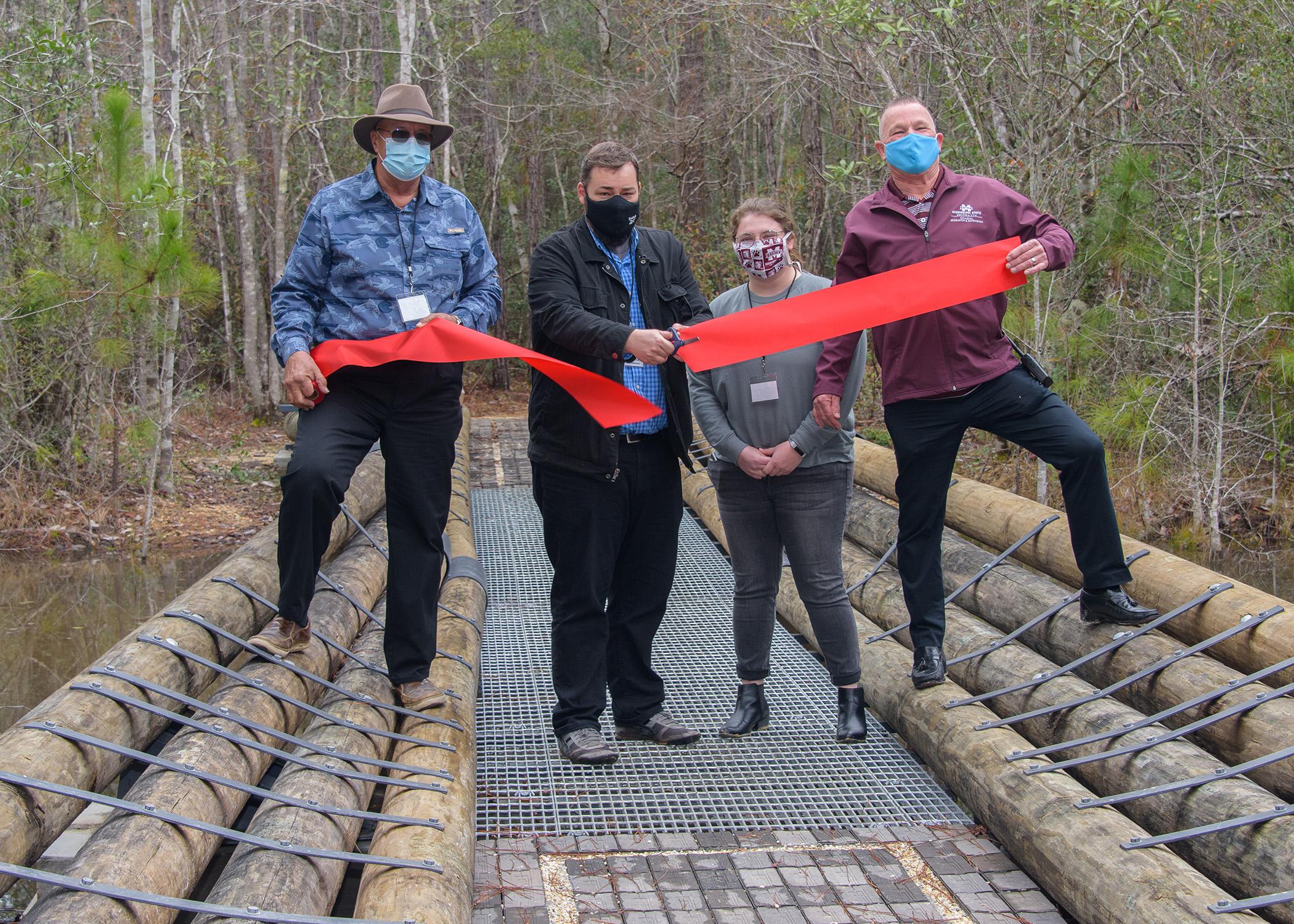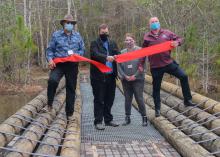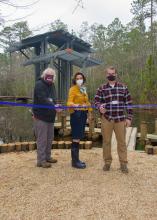Information Possibly Outdated
The information presented on this page was originally released on February 1, 2021. It may not be outdated, but please search our site for more current information. If you plan to quote or reference this information in a publication, please check with the Extension specialist or author before proceeding.
MSU Crosby Arboretum opens new bridge, pavilion to public
PICAYUNE, Miss. -- Two new architectural features at the Mississippi State University Crosby Arboretum in Picayune are now open to the public.
The Mirror Perch Bridge and the adjacent Rosen Pavilion were formally unveiled during a ribbon cutting and dedication ceremony Jan. 23.
Both structures are located within the Gum Pond educational exhibit on the north end of the nationally renowned native plant conservatory. They enhance the educational experience and highlight the pond’s ecological importance.
Bob Brzuszek is an MSU Extension professor in the Department of Landscape Architecture who has been involved with both the arboretum’s master plan process and various landscape architecture projects since the 1980s. He said the completion of the Gum Pond project is one more step in the arboretum’s mission to bring people closer to nature and help them understand how they are linked to the natural world.
“The arboretum exists to help people maintain a connection with nature and to teach them about that connection with the earth,” Brzuszek said. “Over the years here, we’ve tried to create a harmony between people and nature around us.”
Begun more than 10 years ago, the Gum Pond educational exhibit reached a milestone in November 2020 with the completion of the bridge and pavilion. The exhibit serves as an outdoor classroom for students and the public to learn how semi-permanently flooded gum swamp forests contribute to water quality in the Gulf Coastal Plain. More interpretive signage and plants will be added to the exhibit soon.
The Mirror Perch Bridge was designed by Hans C. Herrmann, an associate professor in the MSU School of Architecture. It was built with Five Star Restoration grant funds, donations from arboretum members, and assistance from architecture, construction and landscape architecture student interns.
“I first came to the arboretum in 2010 as a student, and it is one of the places that I visited in Mississippi that anchored me and convinced me to stay and be a part of this community,” said Herrmann, a native of upstate New York. “I am honored to have been one of the many people involved in this project.
“In the design, I wanted to create a frame for appreciating our natural world. The bridge, pavilion and pond, as a three-part composition, celebrate the heavens and the earth. So, as one stands upon the bridge and sees their reflection in the mirror-like surface of the Gum Pond, they might contemplate their place in the natural world,” he said.
The Rosen pavilion is named in memory of the late Yvette Rosen, a former member of the arboretum foundation board. She and her husband, John, were longtime, avid volunteers and advocates of the arboretum and its mission.
“I remember when I first met them in the 1980s,” Brzuszek said. “They would come out here and camp on a piece of property on the weekends. They loved nature, and they loved being in nature. When they heard about the Crosby Arboretum and what it was trying to do, they became very supportive of everything, from the educational programs to helping build exhibits.”
Designed by Robert Poore, an architect in the ecological design firm Native Habitats Inc., the Rosen Pavilion was a gift to the arboretum from the Rosen family.
Poore said he drew his inspiration from the exhibit surroundings and the Rosen’s home garden, where he spent a little time with them while working on the design.
“They were so nice, and I really enjoyed being with them,” Poore said. “I took everything I learned and observed and felt and came up with what you see today.”
Both structures reference the existing Pinecote Pavilion and footbridges designed by award-winning architect E. Fay Jones and architect Maurice Jennings. The bridge and pavilion were installed mostly by hand because of the exhibit’s delicate ecosystem.
Since 2010, arboretum volunteers, employees, and several classes of architecture, landscape architecture and construction students have played an integral role in the design and construction of the Gum Pond exhibit.
Students worked with local steel and paver manufacturers to design and produce structural and decorative elements of the design. These include the pavers for the bridge walkway and central pole receiver, which holds and aligns the poles that make up the bridge’s rails.
“The Gum Pond exhibit is a great example of how the arboretum plays a role in teaching students hands-on skills and better preparing them for their future careers,” said Pat Drackett, Crosby Arboretum director.
“There were many classes of students who contributed to this project over the years. This project, like the arboretum itself, was meticulously studied before any visible work began. We owe a lot of gratitude to the MSU students and professors, because in addition to the physical work they did to build the structures, they also helped us develop the plans for these projects,” Drackett said.
Anne Rosen, daughter of Yvette and John Rosen, said the pavilion is a fitting tribute to her mother.
“While my mother was very comfortable being in the public eye, she would have been very uncomfortable being the subject of public praise,” Anne Rosen said, speaking on behalf of herself and her brother, Robert Rosen. “Our mother was generous of heart and generous of knowledge, but she was an intensely private person.
“So, it is only fitting that the design and setting of this pavilion is an intimate space meant to promote quiet contemplation, to be with nature and one’s self, to find a moment of solace in a hectic life and to encourage creativity. My brother and I hope you find a bit of peace when you visit there,” she said.
Lynn Gammill and her family decided to convert her father’s property into a plant conservatory after his death. She attended the event and said it is satisfying to see the arboretum continuing to fulfill her family’s intention.
“This is one of the happiest days of my life,” she said. “It is great to see people coming together to make the arboretum successful. The Rosen family has done so much behind the scenes. I’m grateful for them and all the other volunteers and employees who come together to do this work that is very, very special.”
Shortly after its completion, the Mirror Perch Bridge won two architectural awards. The Mississippi chapter of the American Institute of Architects recognized the bridge with its prestigious Sambo Mockbee Spirit of Place Award, which is given to one project in the state each year for design of materials. It also received the Design Honor Award -- one of four given in 2020 -- from the chapter’s design jury.







